Single/Dual/Triple Broadband Metasurface Based Polarisation Converter with High Angular Stability for Terahertz Applications
Abstract
:1. Introduction
2. Design Principle of Polarisation Converter
2.1. Performance Analysis of the Single Broadband Polarisation Conversion Metasurface
2.2. U-V Decomposition Analysis
2.3. Surface Current Distribution
2.4. Oblique Angle Stability
2.5. Parametric Variation of Proposed Converter
3. Multi Broadband Reflective Type Polarisation Converter
3.1. Simulation Results of Dual Broadband PC
3.2. Simulation Results of Triple Broadband PC
4. Conclusions
Author Contributions
Funding
Data Availability Statement
Conflicts of Interest
Appendix A
References
- Tonouchi, M. Cutting-edge terahertz technology. Nat. Photonics 2007, 1, 97–105. [Google Scholar] [CrossRef]
- He, Y.; Chen, Y.; Zhang, L.; Wong, S.; Chen, Z. An overview of terahertz antennas. China Commun. 2020, 17, 124–165. [Google Scholar] [CrossRef]
- Bernier, M.; Garet, F.; Coutaz, J. Determining the complex refractive index of materials in the far-infrared from terahertz time-domain data. In Terahertz Spectroscopy-A Cutting Edge Technology; IntechOpen: London, UK, 2017; pp. 119–141. [Google Scholar]
- Jepsen, P.; Cooke, D.; Koch, M. Terahertz spectroscopy and imaging–Modern techniques and applications. Laser Photonics Rev. 2011, 5, 124–166. [Google Scholar] [CrossRef]
- Song, Z.; Gao, Z.; Zhang, Y.; Zhang, B. Terahertz transparency of optically opaque metallic films. EPL (Europhys. Lett.) 2014, 106, 27005. [Google Scholar] [CrossRef]
- Pati, S.; Dey, S.; Benny, S.; Sahoo, S.; Dey, S. 2D Double Semi Circular Goblet Shaped Angular Stable Dual Band Reflection Type Polarization Converter and Its Application in Radar Cross Section Reduction. In Proceedings of the 2022 IEEE Wireless Antenna And Microwave Symposium (WAMS), Rourkela, India, 5–8 June 2022; pp. 1–5. [Google Scholar]
- Meissner, T.; Wentz, F. Polarization rotation and the third Stokes parameter: The effects of spacecraft attitude and Faraday rotation. IEEE Trans. Geosci. Remote Sens. 2006, 44, 506–515. [Google Scholar] [CrossRef]
- Born, M.; Wolf, E. Principles of Optics: Electromagnetic Theory of Propagation, Interference and Diffraction of Light; Elsevier: Amsterdam, The Netherlands, 2013. [Google Scholar]
- Gansel, J.; Thiel, M.; Rill, M.; Decker, M.; Bade, K.; Saile, V.; Freymann, G.; Linden, S.; Wegener, M. Gold helix photonic metamaterial as broadband circular polarizer. Science 2009, 325, 1513–1515. [Google Scholar] [CrossRef]
- Wei, Z.; Cao, Y.; Fan, Y.; Yu, X.; Li, H. Broadband polarization transformation via enhanced asymmetric transmission through arrays of twisted complementary split-ring resonators. Appl. Phys. Lett. 2011, 99, 221907. [Google Scholar] [CrossRef]
- Yu, N.; Aieta, F.; Genevet, P.; Kats, M.; Gaburro, Z.; Capasso, F. A broadband, background-free quarter-wave plate based on plasmonic metasurfaces. Nano Lett. 2012, 12, 6328–6333. [Google Scholar] [CrossRef]
- Smith, D.; Kroll, N. Negative refractive index in left-handed materials. Phys. Rev. Lett. 2000, 85, 2933. [Google Scholar] [CrossRef]
- Smith, D.; Padilla, W.; Vier, D.; Nemat-Nasser, S.; Schultz, S. Composite medium with simultaneously negative permeability and permittivity. Phys. Rev. Lett. 2000, 84, 4184. [Google Scholar] [CrossRef] [Green Version]
- Pendry, J. Negative refraction makes a perfect lens. Phys. Rev. Lett. 2000, 85, 3966. [Google Scholar] [CrossRef] [PubMed]
- Dey, S.; Dey, S.; Koul, S. Miniaturized dual stop band frequency selective surface with broadband linear co to cross polarization conversion ability. Int. J. RF Microw.-Comput.-Aided Eng. 2021, 31, e22779. [Google Scholar] [CrossRef]
- Sun, H.; Gu, C.; Chen, X.; Li, Z.; Liu, L.; Martin, F. Ultra-wideband and broad-angle linear polarization conversion metasurface. J. Appl. Phys. 2017, 121, 174902. [Google Scholar] [CrossRef]
- Pati, S.; Dey, S.; Sahoo, S.; Dey, S. Double E-Shaped Reflection Type Polarization Converter For Radar Cross Section Reduction. In Proceedings of the 2021 IEEE Indian Conference On Antennas And Propagation (InCAP), Jaipur, India, 13–16 December 2021; pp. 839–842. [Google Scholar]
- Shukoor, M.; Dey, S.; Koul, S.; Poddar, A.; Rohde, U. Broadband linear-cross and circular-circular polarizers with minimal bandwidth reduction at higher oblique angles for RCS applications. Int. J. RF Microw.-Comput.-Aided Eng. 2021, 31, e22693. [Google Scholar] [CrossRef]
- Borgese, M.; Costa, F.; Genovesi, S.; Monorchio, A.; Manara, G. Optimal design of miniaturized reflecting metasurfaces for ultra-wideband and angularly stable polarization conversion. Sci. Rep. 2018, 8, 7651. [Google Scholar] [CrossRef] [PubMed]
- Chen, J.; Nie, H.; Tang, C.; Cui, Y.; Yan, B.; Zhang, Z.; Kong, Y.; Xu, Z.; Cai, P. Highly sensitive refractive-index sensor based on strong magnetic resonance in metamaterials. Appl. Phys. Express 2019, 12, 052015. [Google Scholar] [CrossRef]
- Deng, Y.; Cao, G.; Wu, Y.; Zhou, X.; Liao, W. Theoretical description of dynamic transmission characteristics in MDM waveguide aperture-side-coupled with ring cavity. Plasmonics 2015, 10, 1537–1543. [Google Scholar] [CrossRef]
- Deng, Y.; Cao, G.; Yang, H.; Zhou, X.; Wu, Y. Dynamic control of double plasmon-induced transparencies in aperture-coupled waveguide-cavity system. Plasmonics 2018, 13, 345–352. [Google Scholar] [CrossRef]
- Liang, Y.; Lin, H.; Koshelev, K.; Zhang, F.; Yang, Y.; Wu, J.; Kivshar, Y.; Jia, B. Full-stokes polarization perfect absorption with diatomic metasurfaces. Nano Lett. 2021, 21, 1090–1095. [Google Scholar] [CrossRef]
- Kaveev, A.; Kropotov, G.; Tsypishka, D.; Tzibizov, I.; Vinerov, I.; Kaveeva, E. Tunable wavelength terahertz polarization converter based on quartz waveplates. Appl. Opt. 2014, 53, 5410–5415. [Google Scholar] [CrossRef]
- Xu, S.; Hu, F.; Chen, M.; Fan, F.; Chang, S. Broadband terahertz polarization converter and asymmetric transmission based on coupled dielectric-metal grating. Ann. Phys. 2017, 529, 1700151. [Google Scholar] [CrossRef]
- Woo, J.; Hussain, S.; Jang, J. A terahertz in-line polarization converter based on through-via connected double layer slot structures. Sci. Rep. 2017, 7, 42952. [Google Scholar] [CrossRef] [PubMed]
- Grady, N.; Heyes, J.; Chowdhury, D.; Zeng, Y.; Reiten, M.; Azad, A.; Taylor, A.; Dalvit, D.; Chen, H. Terahertz metamaterials for linear polarization conversion and anomalous refraction. Science 2013, 340, 1304–1307. [Google Scholar] [CrossRef] [PubMed]
- Ma, S.; Wang, X.; Luo, W.; Sun, S.; Zhang, Y.; He, Q.; Zhou, L. Ultra-wide band reflective metamaterial wave plates for terahertz waves. EPL (Europhys. Lett.) 2017, 117, 37007. [Google Scholar] [CrossRef]
- Qi, Y.; Zhang, B.; Liu, C.; Deng, X. Ultra-broadband polarization conversion meta-surface and its application in polarization converter and RCS reduction. IEEE Access 2020, 8, 116675–116684. [Google Scholar] [CrossRef]
- Hong, W.; Zhu, J.; Deng, L.; Wang, L.; Li, S. Perfect terahertz-wave polarization rotator using dual Fabry–Pérot-like cavity resonance metamaterial. Appl. Phys. A 2019, 125, 1–7. [Google Scholar] [CrossRef]
- Ako, R.; Lee, W.; Bhaskaran, M.; Sriram, S.; Withayachumnankul, W. Broadband and wide-angle reflective linear polarization converter for terahertz waves. APL Photonics 2019, 4, 096104. [Google Scholar] [CrossRef]
- Zheng, Z.; Luo, Y.; Yang, H.; Yi, Z.; Zhang, J.; Song, Q.; Yang, W.; Liu, C.; Wu, X.; Wu, P. Thermal tuning of terahertz metamaterial absorber properties based on VO2. Phys. Chem. Chem. Phys. 2022, 24, 8846–8853. [Google Scholar] [CrossRef]
- Chen, H.; Chen, Z.; Yang, H.; Wen, L.; Yi, Z.; Zhou, Z.; Dai, B.; Zhang, J.; Wu, X.; Wu, P. Multi-mode surface plasmon resonance absorber based on dart-type single-layer graphene. RSC Adv. 2022, 12, 7821–7829. [Google Scholar] [CrossRef]
- Pouyanfar, N.; Nourinia, J.; Ghobadi, C. Multiband and multifunctional polarization converter using an asymmetric metasurface. Sci. Rep. 2021, 11, 9306. [Google Scholar] [CrossRef]
- Ahmad, T.; Rahim, A.; Bilal, R.; Noor, A.; Maab, H.; Naveed, M.; Madni, A.; Ali, M.; Saeed, M. Ultrawideband Cross-Polarization Converter Using Anisotropic Reflective Metasurface. Electronics 2022, 11, 487. [Google Scholar] [CrossRef]
- Zou, M.; Su, M.; Yu, H. Ultra-broadband and wide-angle terahertz polarization converter based on symmetrical anchor-shaped metamaterial. Opt. Mater. 2020, 107, 110062. [Google Scholar] [CrossRef]
- Cheng, Y.; Gong, R.; Wu, L. Ultra-broadband linear polarization conversion via diode-like asymmetric transmission with composite metamaterial for terahertz waves. Plasmonics 2017, 12, 1113–1120. [Google Scholar] [CrossRef]
- Rao, Y.; Pan, L.; Ouyang, C.; Xu, Q.; Liu, L.; Li, Y.; Gu, J.; Tian, Z.; Han, J.; Zhang, W. Asymmetric transmission of linearly polarized waves based on Mie resonance in all-dielectric terahertz metamaterials. Opt. Express 2020, 28, 29855–29864. [Google Scholar] [CrossRef] [PubMed]
- Li, N.; Mei, J.; Gong, D.; Shi, Y. Broadband and tunable terahertz polarization converter based on graphene composite metasurface. Opt. Commun. 2022, 521, 128581. [Google Scholar]
- Zhu, J.; Li, S.; Deng, L.; Zhang, C.; Yang, Y.; Zhu, H. Broadband tunable terahertz polarization converter based on a sinusoidally-slotted graphene metamaterial. Opt. Mater. Express 2018, 8, 1164–1173. [Google Scholar] [CrossRef]
- Zheng, X.; Xiao, Z.; Ling, X. A tunable hybrid metamaterial reflective polarization converter based on vanadium oxide film. Plasmonics 2018, 13, 287–291. [Google Scholar] [CrossRef]
- Zhao, J.; Cheng, Y.; Cheng, Z. Design of a photo-excited switchable broadband reflective linear polarization conversion metasurface for terahertz waves. IEEE Photonics J. 2018, 10, 1–10. [Google Scholar] [CrossRef]
- Xiao, Z.; Zou, H.; Zheng, X.; Ling, X.; Wang, L. A tunable reflective polarization converter based on hybrid metamaterial. Opt. Quantum Electron. 2017, 49, 1–11. [Google Scholar]
- Yu, X.; Gao, X.; Qiao, W.; Wen, L.; Yang, W. Broadband tunable polarization converter realized by graphene-based metamaterial. IEEE Photonics Technol. Lett. 2016, 28, 2399–2402. [Google Scholar] [CrossRef]
- Yan, D.; Feng, Q.; Yuan, Z.; Meng, M.; Li, X.; Qiu, G.; Li, J. Wideband switchable dual-functional terahertz polarization converter based on vanadium dioxide-assisted metasurface. Chin. Phys. B 2022, 31, 014211. [Google Scholar] [CrossRef]
- Xiao, J.; Huang, X.; Ma, X. Ultra-broadband and High Efficiency Reflection Polarization Converter Metasurface. In Proceedings of the 2021 International Conference On Microwave And Millimeter Wave Technology (ICMMT), Nanjing, China, 23–26 May 2021; pp. 1–3. [Google Scholar]
- Tamim, A.; Hasan, M.; Faruque, M. Highly Efficient Metasurface Polarization Converter at Far-Infrared Range. Front. Phys. 2022, 10, 314. [Google Scholar] [CrossRef]
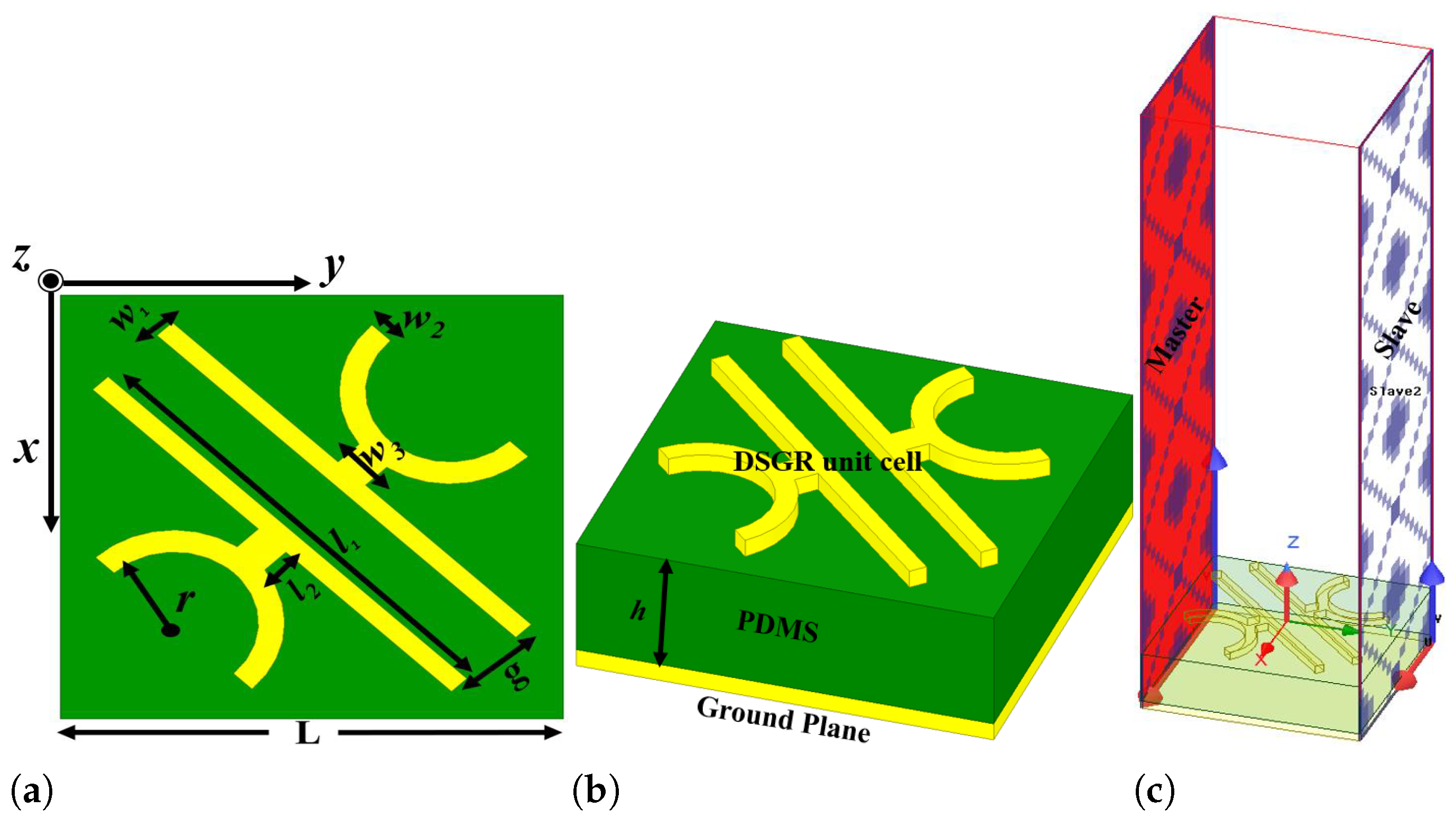
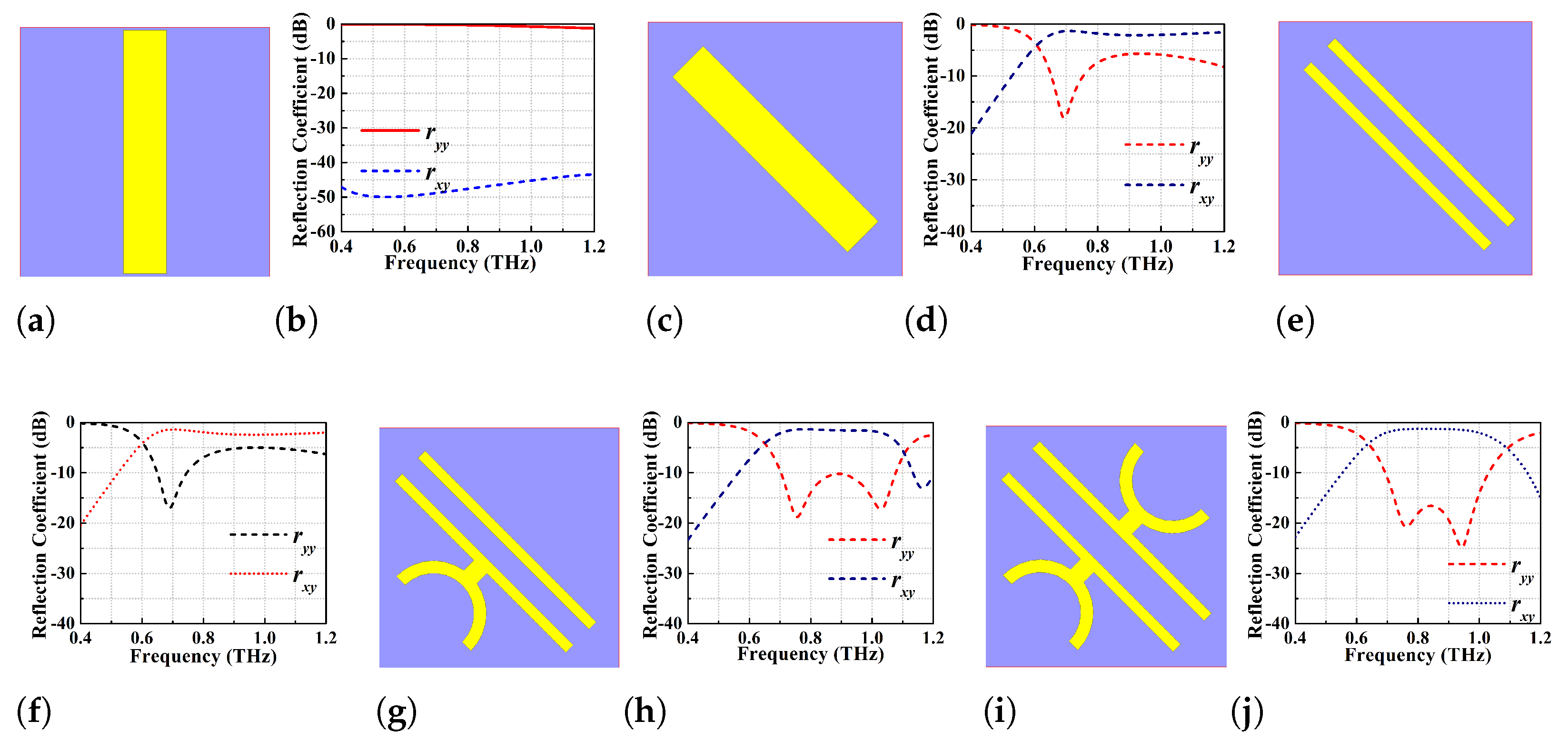
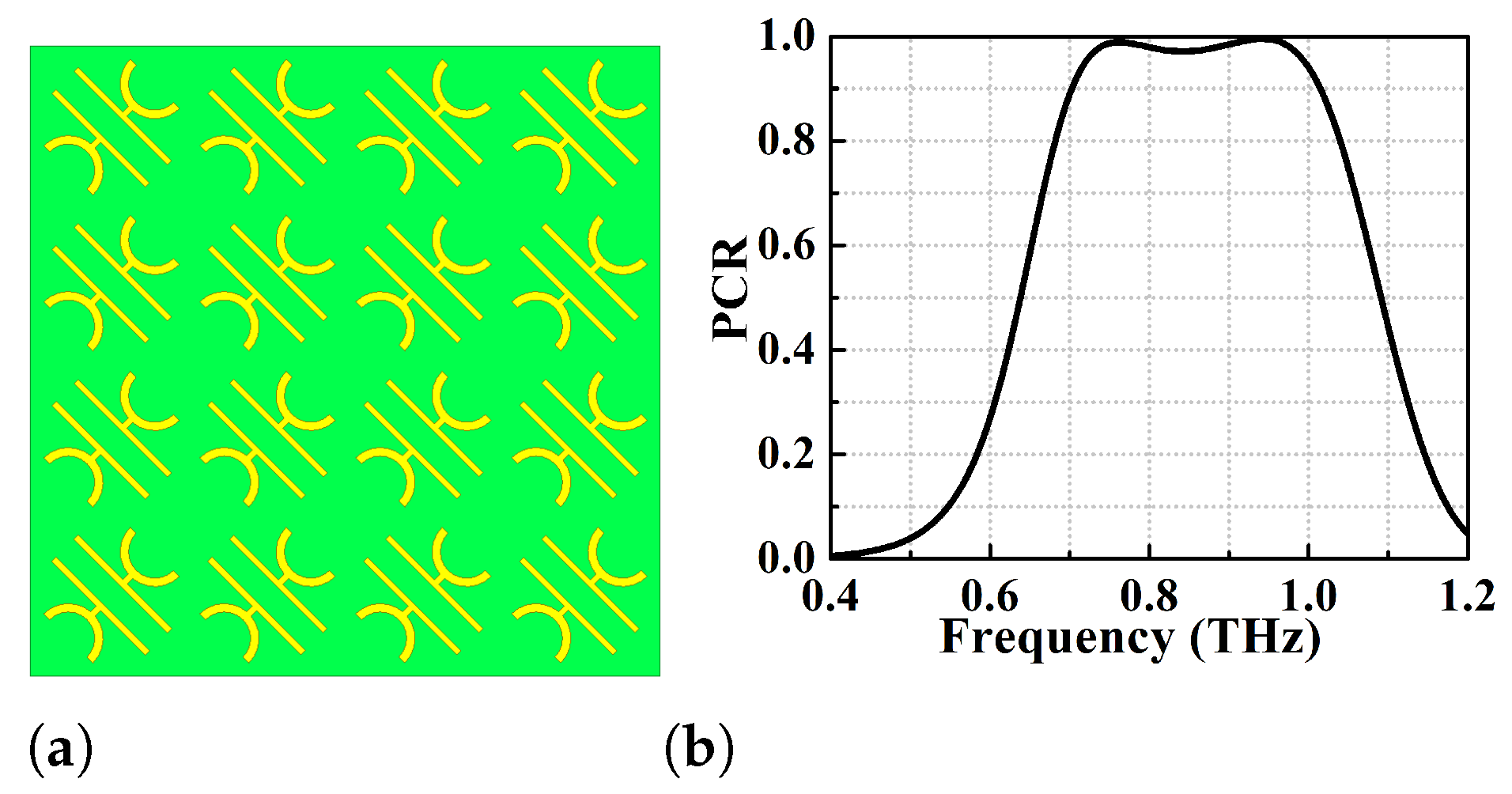





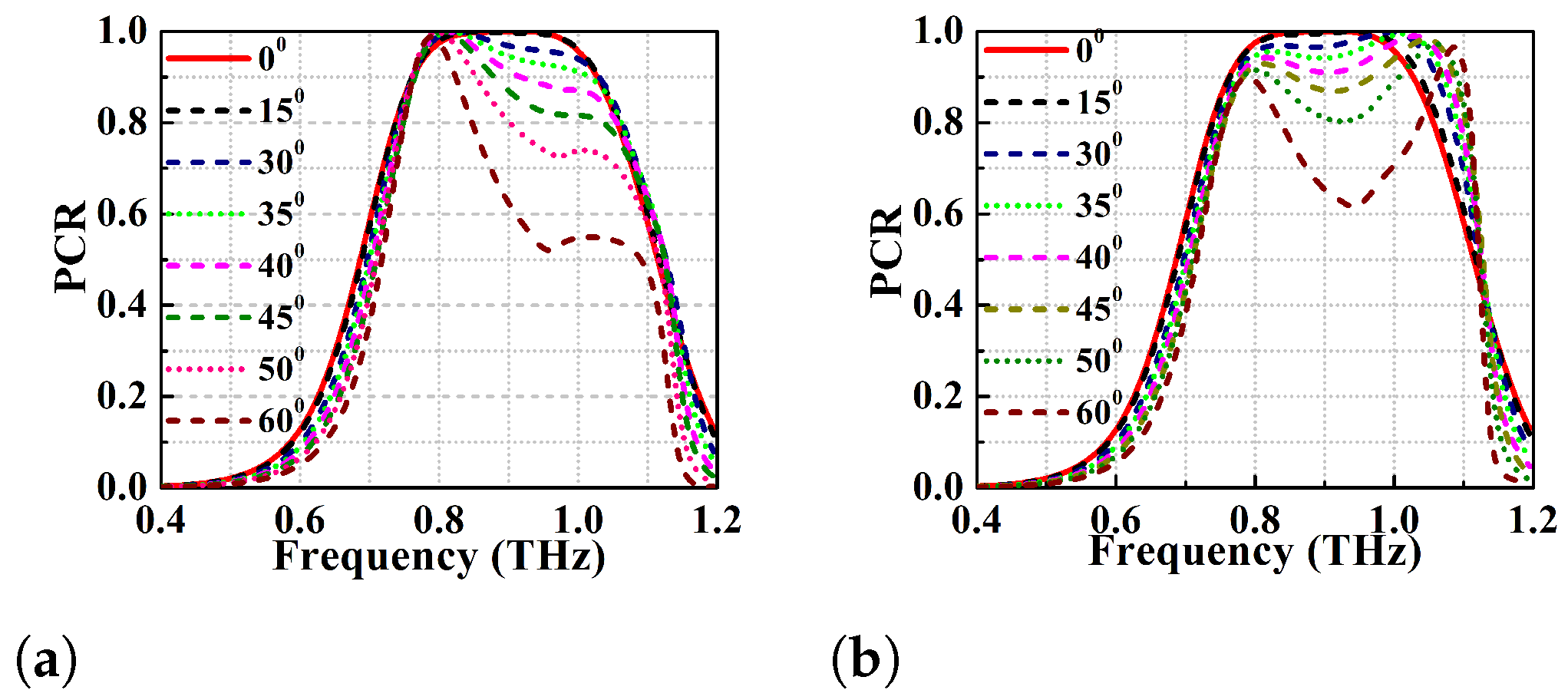

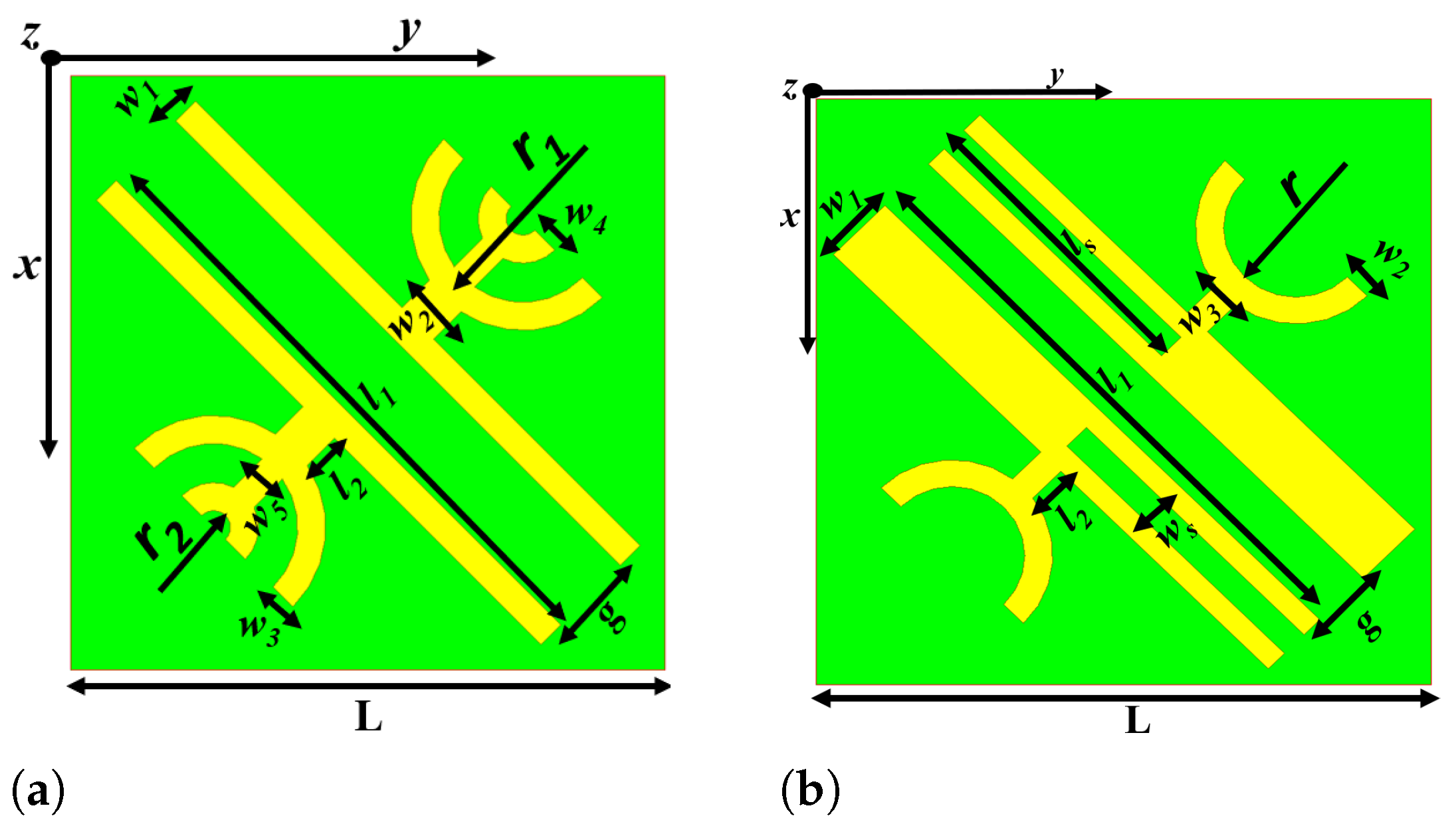




| L (m) | (m) | (m) | (m) | t (nm) | (m) | (m) | r (m) | g (m) | h (m) |
|---|---|---|---|---|---|---|---|---|---|
| 116 | 5 | 9 | 6 | 200 | 117 | 6.5 | 25.5 | 10.5 | 33 |
| Reflection Coefficient | Step I | Step II | Step III | Step IV | Step V |
|---|---|---|---|---|---|
| (dB) | 0 | <−5 | ≤−5 | <−10 | <−16 |
| (dB) | <−48 | ≤−2.5 | <−2.5 | >−2.5 | >−2 |
| L (m) | (m) | (m) | (m) | (m) | (m) | (m) | (m) | (m) | (m) | g (m) | h (m) |
|---|---|---|---|---|---|---|---|---|---|---|---|
| 106 | 5 | 8 | 5 | 5 | 5 | 112 | 6.5 | 15 | 8 | 13 | 38 |
| L (m) | (m) | (m) | (m) | (m) | (m) | (m) | (m) | r (m) | g (m) | h (m) | t (nm) |
|---|---|---|---|---|---|---|---|---|---|---|---|
| 110 | 13 | 5 | 5 | 6.875 | 55 | 110 | 7 | 18 | 15.5 | 36 | 200 |
| Ref. | Substrate | Periodicity of the unit Cell (in ) | Response of the Converter | Operating Frequency with% PCR | Angular Stability with Reduced PCR | 100% Broadband PCR BW | Type of the Converter | Unit Cell Geometry | No. of Dielectric Layers |
|---|---|---|---|---|---|---|---|---|---|
| [29] | Polymide | 0.442 | Broadband | 2.04–5.33, >90 | , NA | No | Reflective | Double-split ring resonator (DSRR) | 1 |
| [30] | Silica | 0.480 | Broadband | 2.9–4.3, >90 | NA | No | Transmissive | Dual Fabry-perot cavity resonator | 1 |
| [31] | COC | 0.281 | Broadband | 0.34–1.04, >80 | >, 80% | Single frequency band | Reflective | T-shape | 1 |
| [36] | PTFE | 0.471 | Broadband | 1.21–2.83, >93 | , NA | No | Reflective | Anchor shaped resonator | 1 |
| [37] | BCB | 0.280 | Broadband | 0.23–1.17, >90 | NA | No | Transmissive | Split disk | 1 |
| [38] | Silicon | 0.609 | Narrowband | only at 0.83 THz, NA | NA | No | Transmissive | Asymmetric Silicon pairs | 1 |
| [39] | Polymide | 0.294 | Broadband | 2.1–3.6, >95 | NA | No | Reflective | Open metal ring | 1 |
| [40] | Quartz | 0.091 | Broadband | 1.28–2.13, >85 | , 80% | No | Reflective | Sinusoidally slotted graphene | 1 |
| [41] | VO | 0.478 | Broadband | 4.95–9.39, >90 | NA | No | Reflective | E-shape | 1 |
| [42] | PDMS | 0.409 | Broadband | 0.65–1.58, >80 | NA | No | Reflective | DSRR | 1 |
| [43] | Polymide | 0.356 | Broadband | 2.10–5.03, >90 | , 80% | No | Reflective | I-shape | 1 |
| [44] | SiO | 0.270 | Broadband | 0.4–0.95, >88 | , NA | No | Reflective | I-shape | 1 |
| [45] | VO, Polymide | 0.407 | Broadband | 0.912–2.146, >90 | NA | No | Reflective | Circular split ring resonator | 2 |
| [46] | TOPAS | 0.454 | Broadband | 1.02–2.76, >90 | NA | No | Reflective | Split ring | 1 |
| [47] | GaAs | 0.196 | Dual broadband | 0.987–1.062, 0.442–0.537 >90 | 1st band: >, 2nd band: < | No | Reflective | Arrow shape | 1 |
| This work | PDMS | Single 0.292 | Single/Dual/ Triple Broadband polarisation conversion | Single broadband (i) for m 0.72–0.99, >95 (ii) for m 0.85–0.945, 100 | Single > (TE and TM) >80% | Single 95 GHz | Reflective | DSGR | 1 |
| Dual 0.270 | Dual broadband 0.70–1.08, >95 1.61–1.76, >95 | Dual Overall: (TE and TM) 92% 1st band: >, >88% | Dual No | ||||||
| Triple 0.277 | Triple broadband 0.67–0.85, >95 1.04–1.11, >95 1.62–1.76, >95 | Triple Overall , 90% 1st band: , >90% but BW is reduced to half | Triple 1st band: 90 GHz 2nd band: No 3rd band: 30 GHz |
Publisher’s Note: MDPI stays neutral with regard to jurisdictional claims in published maps and institutional affiliations. |
© 2022 by the authors. Licensee MDPI, Basel, Switzerland. This article is an open access article distributed under the terms and conditions of the Creative Commons Attribution (CC BY) license (https://creativecommons.org/licenses/by/4.0/).
Share and Cite
Pati, S.S.; Sahoo, S. Single/Dual/Triple Broadband Metasurface Based Polarisation Converter with High Angular Stability for Terahertz Applications. Micromachines 2022, 13, 1547. https://doi.org/10.3390/mi13091547
Pati SS, Sahoo S. Single/Dual/Triple Broadband Metasurface Based Polarisation Converter with High Angular Stability for Terahertz Applications. Micromachines. 2022; 13(9):1547. https://doi.org/10.3390/mi13091547
Chicago/Turabian StylePati, Shyam Sundar, and Swaroop Sahoo. 2022. "Single/Dual/Triple Broadband Metasurface Based Polarisation Converter with High Angular Stability for Terahertz Applications" Micromachines 13, no. 9: 1547. https://doi.org/10.3390/mi13091547






